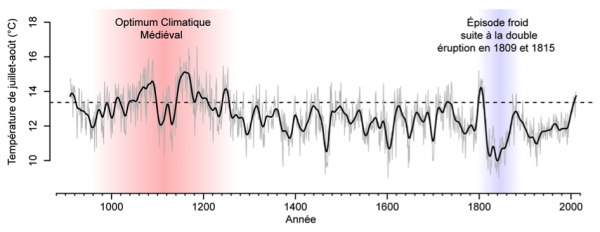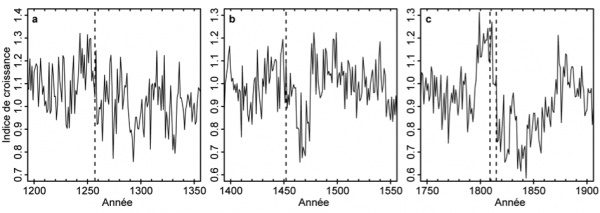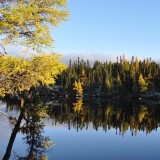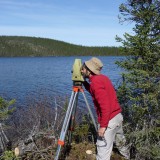Dendroecologic and dendroclimatic analyses of large woody debris in lakes of the north american taiga, Fabio Gennaretti, Ph. D.
The objective of this thesis was to perform dendroecologic and dendroclimtic analyses of large stocks of sub fossil trunks in lakes of the north american taiga. We have reconstructed the climatic trends of the last millennium, as well as fire disturbance impacts in lakeshore forests with high spatial and temporal resolutions.

In the first chapter (Gennaretti et al. 2014a), tree ring dating of tree remains from the littoral zone of five lakes allowed us reconstructing stocks and fluxes of large woody debris (Figure 1). Results show that fire disturbance in the lakeshore forests strongly influence inputs of woody debris in lakes, generally interrupting inputs over more than a century. Fire impacts propagate in time over several centuries due to the slow decomposition of tree remains into the littoral environment.
In the second chapter, (Gennaretti et al. 2014b). We compared the structure and composition of lakeshore forests to the stocks of tree remains that have accumulated into the littoral zone. Results shows that fire disturbance during the last millennia decreased tree density and excluded balsam fir in forests of the study area. Fire impacts in the lakeshore environment were fire-specific and lasted for several centuries.
 In the third chapter, (Gennaretti et al 2014c), we reconstructed summer temperatures of the last 1100 years, based on the tree ring widths of more than 1700 tree remains from six lakes. Ring width were calibrated on summer temperatures of the last century and reconstructed temperatures of the last millenium were compared with records of sulfates peaks from volcanic origin into Greenland and Antarctic ice sheets. Results suggest an important volcanic forcing of summer temperatures and tree growth in northern Québec. An abrupt decrease of summer temperatures from the Medieval Warm Anomaly (900-1250 CE) to the cold period of the Little Ice Age (1250-1870 CE) coincided with the huge eruption of the Samalas in 1257 CE. A subsequent series of strong eruptions in 1809 and 1815 corresponded to the coldest 40 years period of the last 1100 years. Our reconstruction suggests that the 20th century was colder than the Medieval Period, in spite of a sharp temperature increase over the last 30 years.
In the third chapter, (Gennaretti et al 2014c), we reconstructed summer temperatures of the last 1100 years, based on the tree ring widths of more than 1700 tree remains from six lakes. Ring width were calibrated on summer temperatures of the last century and reconstructed temperatures of the last millenium were compared with records of sulfates peaks from volcanic origin into Greenland and Antarctic ice sheets. Results suggest an important volcanic forcing of summer temperatures and tree growth in northern Québec. An abrupt decrease of summer temperatures from the Medieval Warm Anomaly (900-1250 CE) to the cold period of the Little Ice Age (1250-1870 CE) coincided with the huge eruption of the Samalas in 1257 CE. A subsequent series of strong eruptions in 1809 and 1815 corresponded to the coldest 40 years period of the last 1100 years. Our reconstruction suggests that the 20th century was colder than the Medieval Period, in spite of a sharp temperature increase over the last 30 years.

Figure 4: Impact on tree growth of the three larger volcanic eruptions of the last millenia. Dashed vertical lines correspond to the Samalas (1257 CE; a ), Kuwae (1452; b) and 1809 (unknown) and Tambora (1815; c) eruptions.
References:
Gennaretti, F., D. Arseneault and Y. Bégin. 2014a. Millennial stocks and fluxes of large woody debris in lakes of the North American taiga. Journal of Ecology, 102: 367-380.
Gennaretti, F., D. Arseneault and Y. Bégin. 2014b. Millennial disturbance-driven forest stand dynamics in the Eastern Canadian taiga reconstructed from subfossil logs. Journal of Ecology, 102: 1612-1622.
Gennaretti, F., D. Arseneault, A. Nicault, L. Perreault and Y. Bégin. 2014c. Volcano-induced regime shifts in millennial tree ring chronologies from Northeastern North America. Proceedings of the National Academy of Sciences of the USA,111: 10077-10082


